
In August 1990, the world witnessed the unfolding of a critical military operation that would significantly shape the course of the Gulf War: Operation Desert Shield. This operation, a defensive maneuver initiated by the United States and its allies, was a response to Iraq's invasion of Kuwait, a small but oil-rich country in the Persian Gulf. The invasion, led by Iraqi President Saddam Hussein, threatened not only the sovereignty of Kuwait but also the stability of the entire Middle East region and the global oil supply.
The genesis of Operation Desert Shield can be traced back to the complex geopolitical landscape of the late 20th century. The Middle East, rich in oil reserves, had always been a region of strategic importance. Iraq's aggressive move towards Kuwait was driven by a mix of economic desperation and regional ambition. Saddled with debts from its war with Iran and eyeing Kuwait's oil wealth, Iraq sought to assert its dominance. This invasion posed a direct challenge to the West, particularly the United States, which had vested interests in the stability of oil supplies from the Gulf.
In response, President George H.W. Bush, in a show of international solidarity and strength, quickly assembled a coalition of forces. This coalition, one of the largest since World War II, included troops from over 34 countries, symbolizing a united front against aggression. Operation Desert Shield's primary objective was to defend Saudi Arabia, another key oil-producing country, from potential Iraqi aggression. Saudi Arabia's vulnerability was of significant concern; its fall would have given Iraq control over a substantial portion of the world's oil reserves.
The operation involved a massive mobilization of military assets. The United States, leading the effort, deployed hundreds of thousands of troops, along with a formidable array of tanks, aircraft, and naval vessels. This rapid deployment was a testament to the logistical prowess and military readiness of the U.S. Armed Forces and their allies. The strategic positioning of forces in Saudi Arabia served as a powerful deterrent against Iraqi expansion, effectively containing Hussein's ambitions beyond Kuwait.
One of the most notable aspects of Operation Desert Shield was the use of cutting-edge military technology. The operation saw the deployment of advanced weaponry and equipment, including stealth fighters, precision-guided munitions, and extensive use of satellite and surveillance technologies. This high-tech approach to warfare was a significant departure from previous conflicts and set the stage for modern military engagements.
Moreover, Operation Desert Shield was not just a military endeavor; it was also a diplomatic and economic campaign. The United Nations Security Council played a crucial role, passing resolutions that condemned Iraq's invasion and imposed economic sanctions. These sanctions aimed to pressure Iraq into withdrawing from Kuwait, showcasing the international community's preference for a peaceful resolution.
As Operation Desert Shield progressed, it laid the groundwork for what would eventually become Operation Desert Storm, the combat phase of the Gulf War. The months of preparation, strategic positioning, and coalition-building during Desert Shield were critical in setting the stage for the successful liberation of Kuwait.
However, the operation was not without its challenges and controversies. The massive military build-up and the presence of foreign troops in Saudi Arabia stirred political and religious tensions in the region. It also raised questions about the motives of the United States and its allies, with critics arguing that the operation was more about securing oil interests than defending Kuwaiti sovereignty.
In conclusion, Operation Desert Shield was a pivotal moment in the Gulf War and in the broader context of post-Cold War international relations. It demonstrated the effectiveness of rapid military mobilization, coalition-building, and the use of advanced technology in modern warfare. While it successfully achieved its immediate military objectives, the operation also had far-reaching implications, shaping the geopolitical landscape of the Middle East and influencing military strategies and alliances in the years to come. The legacy of Operation Desert Shield remains a subject of study and discussion among military strategists, historians, and policymakers, as it continues to provide valuable insights into the complexities of international conflict and cooperation.